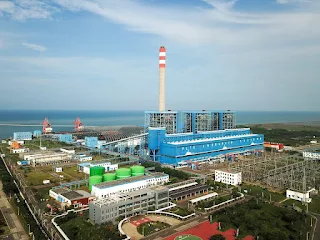INDRAMAYU
THERMAL POWER PLANT
- Investment Value: IDR
29.5 Trillion
- Funding Scheme: State
Budget with foreign loans
- Location: Indramayu,
West Java
- Project Manager: PT PLN
- Construction
Commencement Plan: 2022
- Operation Commencement
Plan: 2026
- Project Status:
Preparation Stage
Project Description
Construction of a 1,000
MW steam-powered power plant that will generate electricity for the needs of
Java and Bali.
Project Significance
The construction of this
PLTU aims to support the provision of an electricity system and reduce the
electricity crisis in the Java and Bali regions. In addition, this project is
also useful for creating economic growth and creating a positive impact on the
community by supporting the growth of industrial areas in East Jakarta and West
Java.
Project Development
Status
PREPARATION STAGE
January 20, 2020 by
ahmadhidayat
Getting to Know the
Indramayu PLTU, a Power Plant on the East Side of West Java
Indramayu, January 19,
2020 – The Indramayu PLTU is a steam-powered power plant located in Sumuradem
Village, Sukra District, Indramayu Regency, West Java. The power plant managed
by a subsidiary of PLN, PT Pembangkitan Jawa Bali (PJB) has a total energy
capacity of 3×330 megawatts (MW).
The energy produced by
this power plant is capable of supplying electricity in the Java and Bali
regions. Since 10 years ago, the Indramayu PLTU has been known as a national
vital object, which supplies electricity to Java and Bali, especially the West
Java and DKI Jakarta areas.
The northern side of the
Indramayu power plant is directly adjacent to the north coast of Java Island.
On the other side, this power plant is surrounded by green rice fields.
In 2019, PLTU Indramayu
successfully received the Green Proper award. Proper is a program to assess the
performance rating of companies in environmental management developed by the
Ministry of Environment (KLH) since 1995. This program is carried out to
encourage companies to improve their environmental management.
Green Proper is given to
companies that have carried out environmental management beyond that required
by KLH.
PLTU Indramayu utilizes
the remaining coal combustion results in the form of fly ash and bottom ash to
be processed into paving blocks.
"The production is
not too big yet, we can produce 500 paving blocks every day. The results of the
paving blocks are used for corporate social responsibility activities for
residents around the power plant," said General Manager of UBJOM
Indramayu, Ubaedi Susanto.
As one of the largest
rice producing areas in West Java, PT PJB also continues to support agriculture
around PLTU Indramayu by encouraging the community to use organic fertilizers
through various training and coaching.
"Previously, people
were worried that using organic fertilizer would reduce the results, but it
turned out to be the same as using synthetic fertilizer, even though the
operational costs of using organic fertilizer are cheaper. Now many people are
interested," said Ubaedi.
TRIAL OF USING WOODEN
PALLETS AS A MIXTURE OF COAL FUEL
The Indramayu PLTU is
also currently conducting a trial of using wooden pallets as a mixture of coal
to generate electricity.
Ubaedi explained that
every day the Indramayu PLTU requires an average of 4,000 tons of coal per
unit, so that the total requirement if 3 units are operating reaches 12,000
tons. By utilizing pallets, it is hoped that coal usage can be reduced.
"Currently it is
still in the trial stage. Yesterday we tried mixing 5% of pallets and the
results were quite satisfactory," said Ubaedi.
The target of this
innovation in using pallets is not only to save the basic cost of provision,
but also to become an alternative energy to replace fossil fuels. This
innovation can also reduce waste and emissions which are currently still a
problem in several areas.
In addition to the
Indramayu PLTU, there are 16 PLN power plants that received the Green Proper,
namely the Priok PLTGU, Suralaya 1-7 PLTU, Pelabuhan Ratu PLTU, Gunung Salak
PLTP, Suralaya 8 PLTU, Paiton 9 PLTU, Tambak Lorok PLTGU, Muara Tawar PLTGU,
Rembang PLTU, Gilimanuk PLTG, Perak Grati PLTGU, Pemaron PLTG, Lontar PLTU,
Keramasan PLTGU and Labuan PLTU.
Even five PLN power
plants managed to get the gold Proper, namely the Tanjung Jati B Steam Power
Plant (PLTU), Jepara which is managed directly by PLN, Paiton Unit 1-2 PLTU,
Probolinggo and Gresik Gas Steam Power Plant (PLTGU) managed by PJB, as well as
Pesanggaran Diesel Gas Power Plant (PLTDG), Denpasar and Kamojang Darajat
Geothermal Power Plant (PLTP), Bandung Regency which are managed by IP.
The Gold Proper is the
highest award given to companies that have carried out environmental management
beyond the requirements and have made efforts to develop the community
sustainably.
Source:










